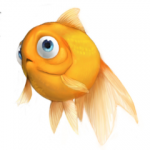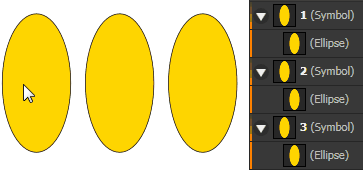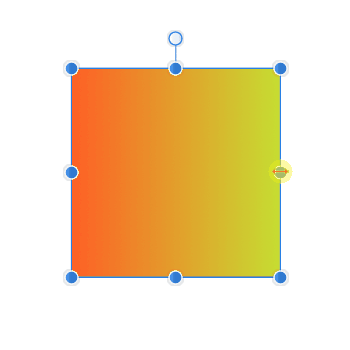-
Posts
1,808 -
Joined
Everything posted by Aammppaa
-
I have a group containing a square and circle. In Vector view a single click on the square will select the entire group. In Outline mode, a single click on the square will select only the square - the equivalent of a Ctrl+Click in Vector mode. Is this by design? If so, please could a comment to this effect be added to the help? -- Although I understand that Outline mode is intended to assist with object selection, the break from convention is confusing, and can lead to unwanted behaviour… In outline view a click on a symbol selects the object within the symbol, so all changes are global (redefining the symbol) rather than local (affecting only that instance). If outline view followed the usual selection conventions it would still be useful for easy selection of objects, would be less confusing, and would not have any unwanted side-effects.
-
@GabrielM I understand the words, but the concept seems very peculiar… I can define a global colour and specify a noise value and opacity. I can edit a global colour to redefine its colour. I can't edit a global colour to redefine its noise value or opacity. I can alter the noise value and opacity locally. Doesn't this go entirely against the concept of global colours?! If opacity / noise can cause issues with global colours why can they be defined at the point of creation? If the complication relates to printing spot colours, why force this limitation on users who are designing for screen?
-

dotted surface
Aammppaa replied to iMac1943's topic in Pre-V2 Archive of Desktop Questions (macOS and Windows)
Or, if it isn't important that it is vector… use a bitmap fill. Affinity Dot Bitmap Pattern.afdesign -

Changing stroke color with rightclick?
Aammppaa replied to Pannonia's topic in Older Feedback & Suggestion Posts
Fingers crossed that Serif will do some work on improving the UI in forthcoming versions. -- What do you mean by Named Colours? You can make your own swatch and name the colours within it. Or perhaps you mean Global Colours? -

Changing stroke color with rightclick?
Aammppaa replied to Pannonia's topic in Older Feedback & Suggestion Posts
This has been requested a number of times before… -
@dominik @Txamo Unfortunately the lack of ability to export a slice with its background seems to have been around for a long time. See this post from 2015! What I have deduced from the help file (which is pretty sparse on this subject to be honest) and experimentation… File > Export explicitly give the option to include or exclude the background. Manually drawing a slice with the Slice Tool is called a "Slice" and exports the background. Automatically creating a slice from an object with Create Slice button is called a "Slice (from item)" and does not export the background. In addition to other suggestions in this thread, it would be advantageous to add a toggle to "Slice (from item)" that allows export including the background.
-

Artboards and margins
Aammppaa replied to Jonopen's topic in [ARCHIVE] Designer beta on Windows threads
Since the Beta installs in parallel with the Retail version, you have nothing to lose by installing it now, and having the fix straight away. And, if you do ever come across a bug in the Beta, simply revert to the Retail to work around the issue. -

Option for Corel Style Node Delete
Aammppaa replied to TonyO's topic in Feedback for Affinity Designer V1 on Desktop
I agree that it would be nice to have a toggle or even make this the default. -

Option for Corel Style Node Delete
Aammppaa replied to TonyO's topic in Feedback for Affinity Designer V1 on Desktop
From Affinity Designer help… To delete nodes: Select the node and press the delete. The curve will automatically reshape because of the deleted node, but you can retain the curve's original geometry by pressing Ctrl+Alt+Backspace instead. This needs to be a node that could be removed and the curve remain similar. NOTE: It isn't perfect (I hope the devs can improve the accuracy in a future update) but is considerably better than simply deleting the node. -
@GabrielM Thanks for getting back to me, but I think that the response misses the point that I raised… If I want to resize a duplicate by percentage I can already do that by using a percentile expression (say -=10%). This is explicit, and unambiguous. When repeated using Power Duplicate, I continue to get what I asked for: a series of objects each 10% smaller than the last, which is intuitive and logical. If I resize by an exact value (say -=50px ) then this is because I want the duplicate to be exactly 50px smaller than the original. Again this is explicit and unambiguous. But when I repeat with Power Duplicate, Affinity changes the rules (with no warning) and starts applying a percentile ratio, which is not what was asked for. This is unintuitive and illogical (not a desirable feature). The two series (fixed steps and percentile ratio) are both desirable and equally valid requirements, so the software must trust that the user knows what they are asking for, and honour the actual request that they made. Although the 'infinite' series of power duplicates looks great in the video as it showcases Affinity's extreme zoom very nicely, I know that I'd use a fixed step series of duplicates far more frequently than I need percentile changes. Regarding a fixed step reaching exactly 0, there must be a simple and graceful way to handle this… Perhaps when the size hits 0 the object ceases to exist (and the existing Assistant pops up to inform me that the object reached zero size and disappeared). Or maybe a zero sized object is OK (though I suspect not since Affinity will not let me define a dimension of 0). Even a situation where we don't hit 0 but go negative is not an issue so long as we understand what a negative dimension means. Take for example an object with original width = 50px, duplicated as a series with a fixed step of -11px = 49, 38, 27, 16, 5, -6, -17 etc. A precedent for what this means already exists in the software: if I resize a rectangle manually and pass through the zero point the object flips (on the relevant axis) and then grows larger again. It would be logical that the same thing happens when a power duplicate action passes through zero. To reiterate: I really hope the devs can revisit the design choices behind Power Duplicate. I am not asking that any existing ability is removed, but rather that the functionality is extended to be more capable, more logical, and more intuitive.
-
But with the system as it currently exists we can not create any linear arrays with rotation, and I know which of those two operations I need more frequently! Secondly, the ratio feature is currently far less useful than it should be as it can only apply a ratio, not a step change… Draw a 500px square Duplicate Resize in the W transform box as -=50 Power Duplicate I would anticipate the series to go: 500, 450, 400, 350, 300 etc But the current result is: 500, 450, 405, 364.5, 328.1 etc Affinity is interpreting the resize as a ratio (a reduction of 10%) when I asked for a fixed change. If I'd wanted a 10% reduction I'd have resized with W*=0.9 I'd love the team to revisit Power Duplicate and make it more intuitive and more versatile.
-
Ah! I finally understand why Power Duplicate behaves as it does, however… The help file does not mention local (or global) coordinates This seems like a very odd design choice! Can you suggest an efficient method, using Power Duplicate (or other tools in Affinity) to create a horizontal row of (45) squares, equally spaced, each rotated 8° from the last?
-
Also look at Compound Shapes which allow easy adjustment of combined objects. Or use your group as a mask on the pixel layer (rather than nesting the pixel layer inside the group).
- 13 replies
-
- pixel layer
- group
-
(and 2 more)
Tagged with:
-

Change of artboard's colour
Aammppaa replied to Przemysław's topic in Older Feedback & Suggestion Posts
-
Daub Essential contains a bunch of pencils… https://gumroad.com/l/IXbWp Or an earlier free version here…
-
-
Photo has a node tool on the flyout from the pen tool.
-

Stripes
Aammppaa replied to RangeRooney's topic in Pre-V2 Archive of Desktop Questions (macOS and Windows)
+1 from me. It should pop out as its own window / panel (as the Effects do if you want to see all the parameters).






